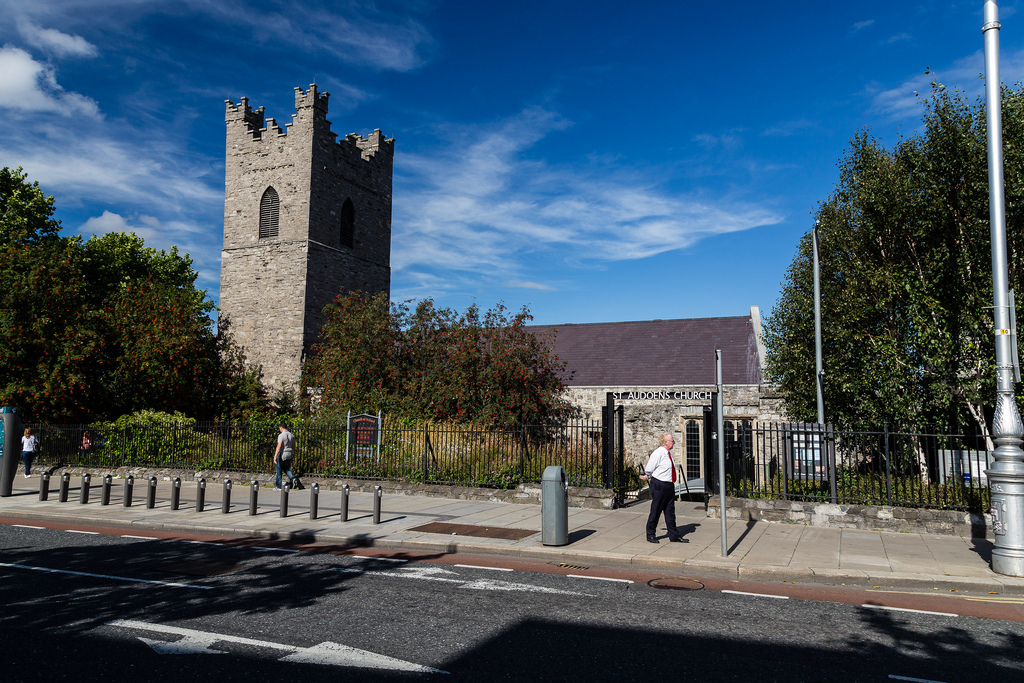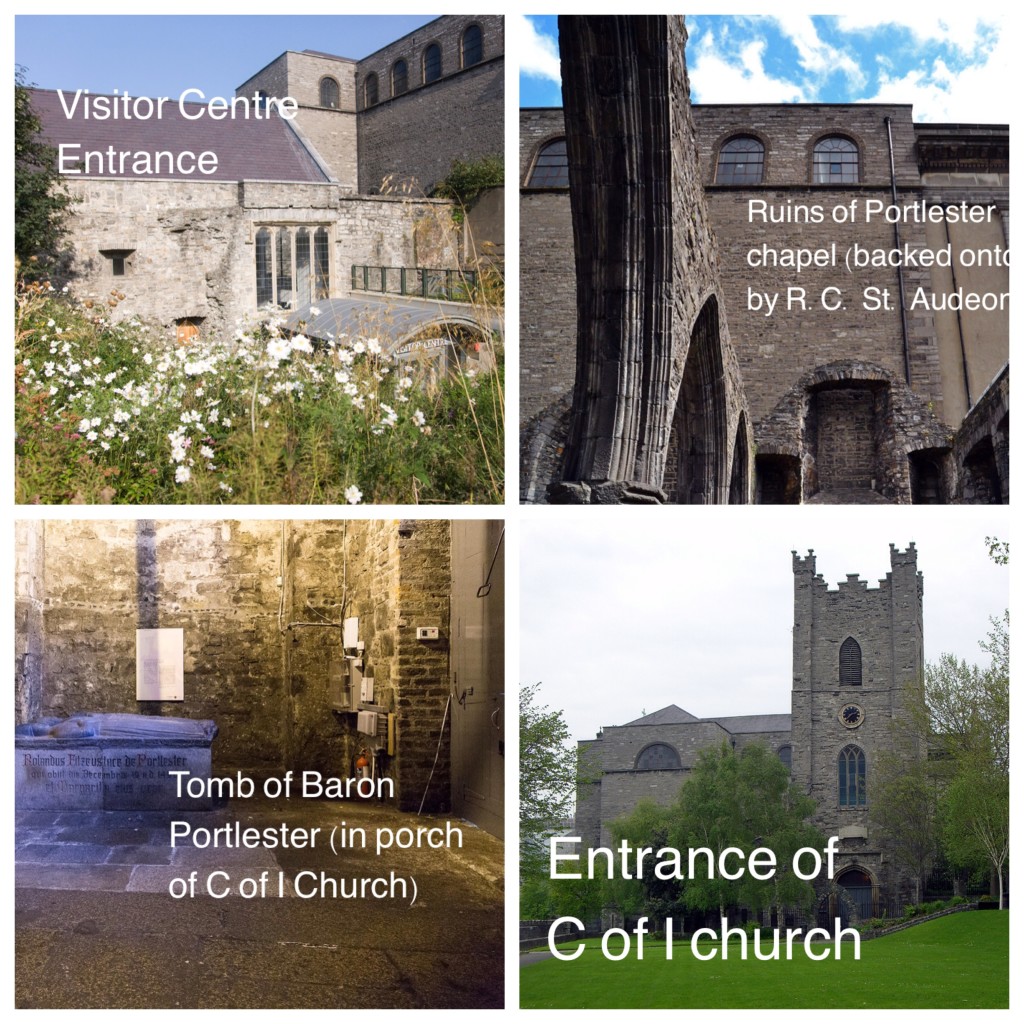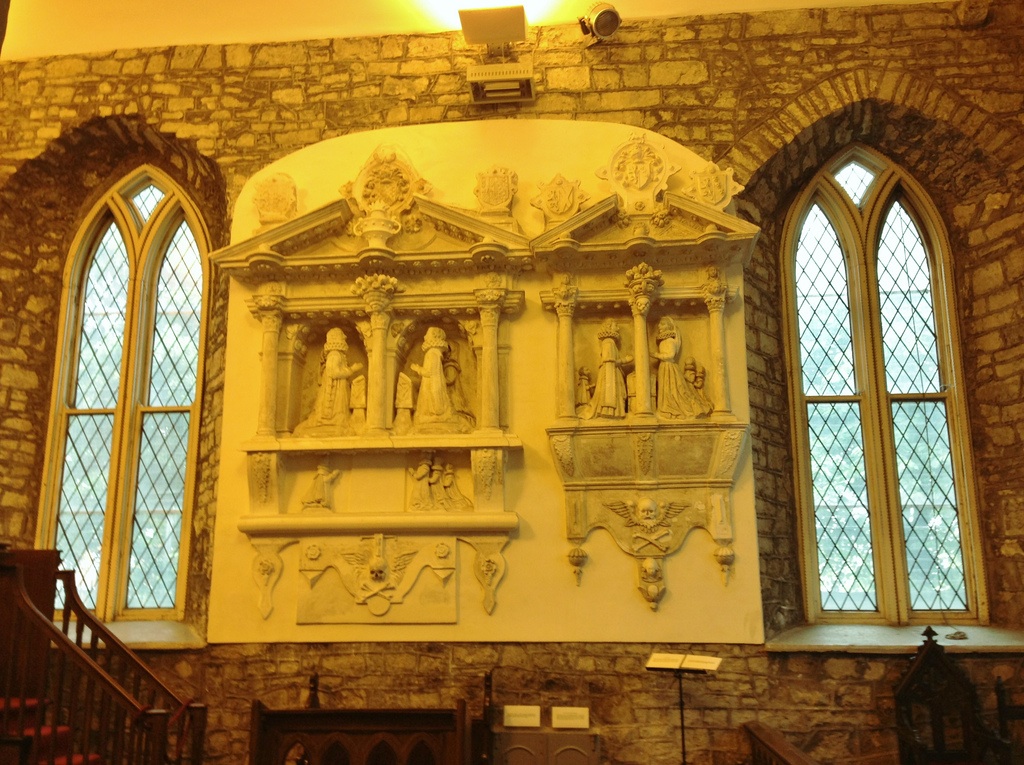Confusingly there are two St Audoen’s churches right next to each other on High Street: one is Roman Catholic (Victorian), and the other is Church of Ireland (Norman). Here we are concentrating on the latter.
Viewed from the bustle and modernity of the raised street that it is entered by (High Street), the church looks small and less illustrious than its neighbours. The Catholic St Audoen’s rises high above it, behind and just to the east; whilst a short distance away, within faint view, is Dublin’s most imposing cathedral: Christ Church Cathedral. However, though the main body of St Audoen’s (Church of Ireland) nestles modestly among its newer neighbours, its bell tower rises proudly above green trees and into the skyline. This bell tower, which dates from the 17th Century, is a mere hint at the age and history of this building – Dublin’s only surviving medieval parish church.

Two Saints
St Audoen’s Church is dedicated to St Audoen – also called St Audoenus (from Latin), St Audoin, St Ouen, St Owen, and Dado (to contemporaries) – he was a 7th Century Bishop of Rouen in Normandy, France.
Ouen, who was born into a family of French nobles in 609 AD, was privileged enough to gain an education at an abbey – abbeys being the principal centres of learning in the Middle Ages. He would later use his education and influence to convince the King of France to grant him a plot of land, upon which he built a monastery. This debt to France was repaid when Ouen, who wanted to embrace the monastic life, was instead persuaded to travel the length and breadth of France promoting the building of centres of religious learning, bringing Christianity to pagans, and teaching religious virtues. Ouen’s pursuit of good deeds would take him as far as Cologne where, in 683, he helped negotiate peace between Neustria and Austrasia. After his death, also in 683, Audoen would become a famous saint across Christian Europe. St Audoen’s Church of Ireland in Dublin would not be built for another 400 years (1180), but in the intervening period the site it would eventually be built upon would come to hold great significance in Dublin.
It was believed that the Norman church had been built on the site of an earlier foundation (St Columba’s), however no archaeological evidence supports this theory. We may never know if this is true. We are lucky to have as many Medieval cathedrals and churches as we do – most were destroyed by fires, poor construction, or other damage. What is not in doubt though, is that the land (now a park) that surrounds the church, and the foundations of the church itself, was a busy and important area for centuries before the construction of the present church. This is testified to by an ancient wall and path that was discovered in 1982, in the foundations of the church and under the park that spread out around it. The wall is believed to be part of the Hiberno-Norse defence of the city before the arrival of the Normans, and parts of it are on view today in the basement of St Audoen’s. Also of interest is a piece of wall in the porch, with a fresco, that dates from between 860 and 900 AD.

The Buildings
As you walk down the steps towards the church, the overall shape becomes clearer. The rectangular, barn-shaped part of the church, that stretches off towards (and then connects with) the bell tower, is St Anne’s Chapel. Behind St Anne’s, so not in view, is a similar, barn-shaped structure. This part of the church, which runs parallel to St Anne’s Chapel, is still in use today as a Church of Ireland Parish Church.
The first part of the church that you will enter is now a visitor centre that enters into St Anne’s Chapel to its left (west). To the right is the Portlester Chapel, which is a designated national monument.
St Anne’s Chapel
St Anne’s Chapel stands on the site where the original St Audoen’s was built at the end of the 12th Century. The original church was much smaller and was made up of just a nave and a chancel. Over the years, with the extension of Norman power, parts of the original church wall were pulled down and used to make extensions. In 1430 it was made a separate part of the church and taken over by the Guild of St Anne’s – a group of religious laymen. Medieval religious guilds were funded by the nobility who left money to them in their wills – in return they received prayers for their souls for many years after their death. The St Anne’s Guild, with its wealthy patronage, contributed much to the architectural development of St Audoen’s over the next few centuries, including rebuilding the bell-tower in the late 15th Century. They also contributed towards many of the interesting artefacts, religious items and documents that exist around the whole church to this day. The eastern end of St Anne’s Chapel now houses the visitor centre; whilst the western now displays evidence of the stunning ruins of the original church.

Portlester Chapel
The Portlester Chapel – a section on the east side of St Audoen’s – is dedicated to Baron Portlester, who paid for its construction in 1482. Between the 14th and 17th Centuries St Audoen’s was a very busy and important church, so it was no surprise that a man who had held the position of Lord Treasurer of Ireland would want a section dedicated to his name. The chapel no longer has a roof and is abandoned to the elements, but it is still a stunning, raw, and powerful section of the church.
The Bell Tower
The Bell Tower has been rebuilt three times – the latest in the 17th Century, and it was also extensively renovated in 1882. Its bells, though, are much older: they were cast in 1423, and are the oldest hanging bells in Ireland.
The church itself
As well as being a stunning tourist attraction; St Audoen’s is in use as a place of worship today. The church, which is entered from the bell tower side, houses many old items that are well worth a look. It also has some beautiful stained-glass windows. Parts of the wall are made up of the original stones that we’re used to build the first Norman church.
